How to Store Garden Tools: A Complete Guide
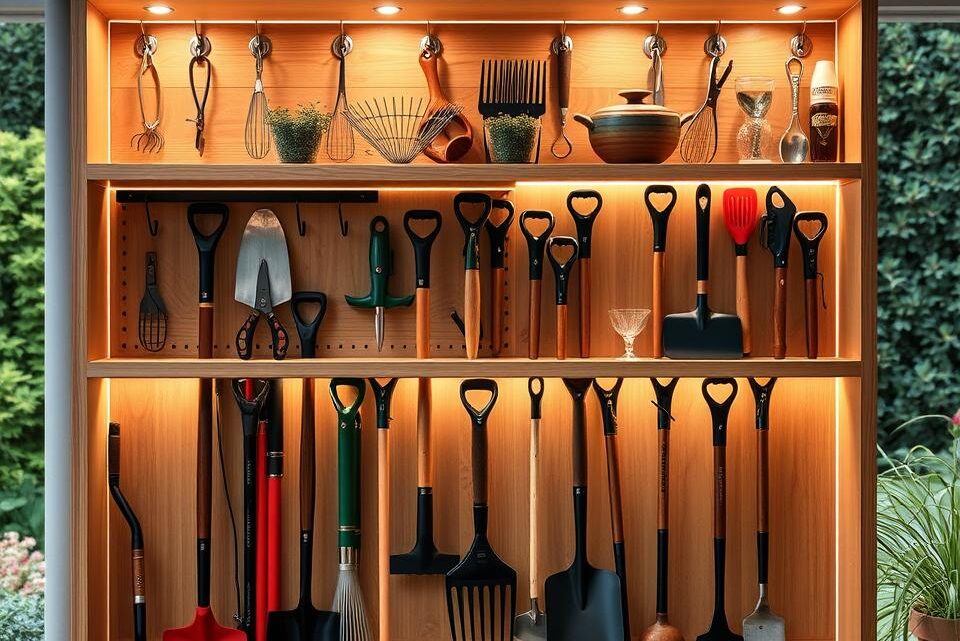
Proper garden tool storage transforms chaotic sheds into organised spaces whilst protecting your valuable equipment investment. Every gardener faces the challenge of keeping their tools clean, accessible, and rust-free throughout changing seasons.
Whether you’re managing a small collection of hand tools or extensive equipment, effective tool organisation extends the lifespan of your garden essentials. From secateurs and trowels to spades and hedge trimmers, each piece requires specific care and attention.
This comprehensive guide explores indoor and outdoor storage solutions that suit different spaces and budgets. You’ll discover maintenance practices, seasonal considerations, and practical tips that prevent damage whilst keeping your equipment ready for action year-round.
Inhaltsverzeichnis
Key Takeaways
- Proper storage prevents rust and extends tool lifespan significantly
- Both indoor and outdoor storage options suit different garden sizes
- Regular cleaning and maintenance are essential before storage
- Seasonal considerations affect storage requirements and methods
- Organisation systems improve accessibility and tool protection
- Different tool types require specific storage approaches
Why Proper Garden Tool Storage Matters
Every gardener knows the frustration of reaching for a favourite spade only to find it covered in rust and barely functional. Proper storage transforms your tools from seasonal disappointments into reliable companions that serve you year after year. The benefits extend far beyond mere organisation, touching every aspect of your gardening experience.
Quality garden tools represent a substantial financial commitment. A complete set from trusted brands like Spear & Jackson or Wilkinson Sword can easily cost several hundred pounds. Without adequate garden equipment care, even premium tools deteriorate rapidly when exposed to moisture and temperature fluctuations.
Protecting Your Investment from Damage
Physical damage occurs more frequently than most gardeners realise. Tools left scattered in sheds often suffer from bent handles, chipped blades, and damaged mechanisms. Proper storage systems prevent these costly accidents by providing designated spaces for each tool.
Handles made from ash or hickory wood are particularly vulnerable to splitting when stored incorrectly. Metal components can become dented or warped when tools are carelessly stacked together. A well-organised storage system eliminates these risks entirely.
Consider the replacement cost of damaged tools. A quality fork or spade typically costs £30-60, whilst premium pruning shears can exceed £80. Effective tool protection measures pay for themselves within the first season.
Preventing Rust and Corrosion
Britain’s damp climate creates perfect conditions for rust formation. Humidity levels often remain elevated for months, particularly during autumn and winter. Metal tools exposed to these conditions develop surface rust within weeks.
Corrosion doesn’t stop at surface level. It penetrates deep into metal, weakening structural integrity and creating rough surfaces that harbour bacteria. Once established, rust spreads rapidly across tool surfaces, making removal increasingly difficult.
The following table illustrates common corrosion timeframes under different storage conditions:
| Storage Condition | Rust Appearance | Severe Damage | Tool Lifespan |
|---|---|---|---|
| Outdoor exposure | 2-3 weeks | 3-4 months | 1-2 years |
| Damp shed | 1-2 months | 6-8 months | 3-5 years |
| Dry, ventilated space | 6-12 months | 2-3 years | 10-15 years |
| Climate-controlled storage | Rarely occurs | 5+ years | 20+ years |
Maintaining Peak Tool Performance
Well-stored tools maintain their sharp edges and smooth operation. Cutting tools like secateurs and shears retain their precision when protected from moisture and impact. Moving parts continue operating smoothly when properly lubricated and stored.
Performance degradation happens gradually but inevitably with poor storage. Blades become dull more quickly when exposed to humidity. Joints and hinges seize up without regular maintenance during storage periods.
Professional landscapers understand this principle intimately. They invest heavily in proper storage because their livelihoods depend on reliable equipment. The same logic applies to home gardeners who want consistent, enjoyable gardening experiences.
Essential Preparation Before Storage
Effective tool maintenance begins with proper preparation before storage, a crucial step that many gardeners unfortunately overlook. This preparation phase determines whether your tools will emerge from storage ready for action or requiring extensive repairs. Taking time to prepare your equipment properly can save you significant money and frustration in the long run.
The preparation process should start immediately after your final gardening session of the season. Delaying this crucial step allows dirt, moisture, and organic matter to cause permanent damage to metal surfaces and wooden handles. Remember, prevention is always more cost-effective than replacement.
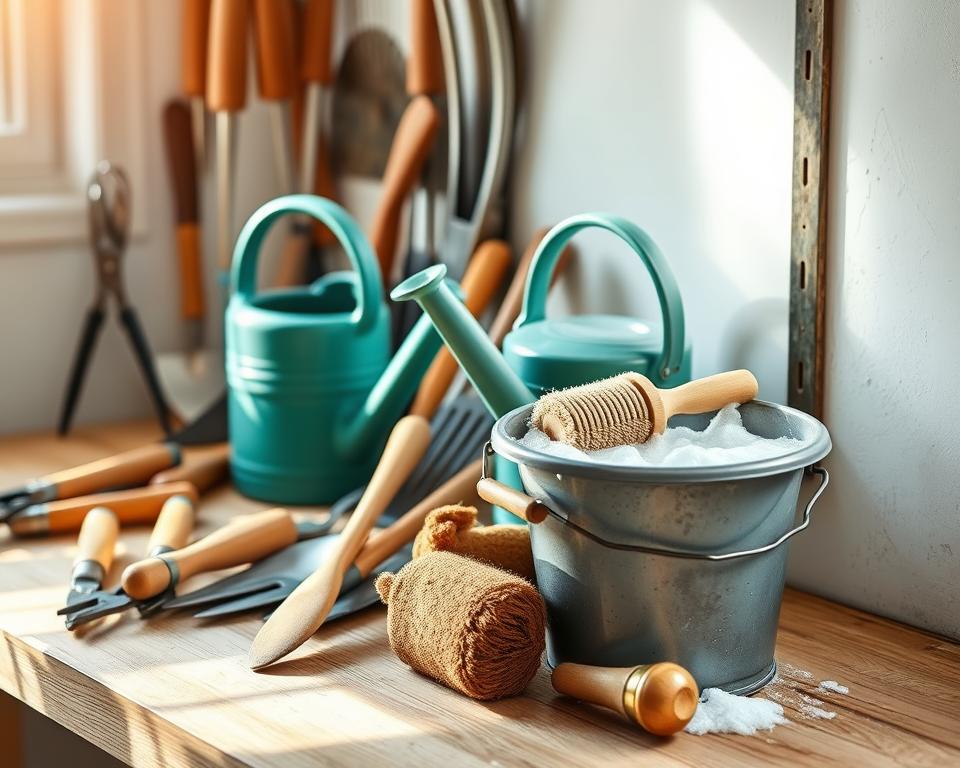
Cleaning Your Garden Tools Thoroughly
Begin your garden tool care routine by removing all visible soil and debris from each implement. Use a stiff-bristled brush or plastic scraper to dislodge hardened earth from blade surfaces and joints. Pay particular attention to areas where dirt commonly accumulates, such as the connection points between handles and tool heads.
For metal tools, warm soapy water works effectively for general cleaning. Scrub away any remaining soil particles and rinse thoroughly with clean water. Avoid using harsh chemicals that might damage protective coatings or wooden components.
Hand tools require special attention to their working surfaces. Clean secateurs and pruning shears by wiping the blades with a damp cloth, ensuring you remove all plant material that could harbour bacteria or fungi.
Removing Sap and Stubborn Debris
Tree sap and sticky residues present particular challenges during the cleaning process. These substances can harden over time, making removal increasingly difficult and potentially damaging tool surfaces. White spirit or methylated spirits prove highly effective for dissolving stubborn sap without harming metal or wood.
Apply the solvent to a clean cloth rather than directly onto the tool. Gently rub the affected areas until the sap begins to dissolve. For particularly stubborn residues, allow the solvent to sit for several minutes before wiping clean.
Commercial tool cleaners offer another excellent option for removing difficult substances. These products are specifically formulated for garden equipment and won’t damage protective finishes. Always follow manufacturer instructions when using any cleaning products.
Drying and Inspection Process
Thorough drying represents the most critical step in preventing rust and corrosion during storage. Even microscopic amounts of moisture can initiate oxidation processes that permanently damage metal components. Use clean, dry cloths to remove all water from tool surfaces, paying special attention to joints and crevices.
Allow tools to air-dry completely in a well-ventilated area before proceeding with storage preparations. This process typically takes 30-60 minutes depending on ambient humidity levels. Never store damp tools, as this guarantees rust formation.
During the drying period, conduct a comprehensive inspection of each tool. Look for signs of wear, damage, or developing rust spots that require immediate attention. Check wooden handles for cracks, splinters, or loose connections that could worsen during storage.
Create a simple checklist to ensure consistent inspection quality:
- Examine blade sharpness and edge condition
- Check handle integrity and grip security
- Inspect moving parts for smooth operation
- Look for rust spots or surface corrosion
- Verify that all components are properly tightened
Document any issues you discover during inspection. This record helps you prioritise maintenance tasks and ensures nothing gets overlooked when preparing tools for the next growing season. Proper preparation now prevents costly repairs later and keeps your garden tool care routine manageable and effective.
How to Store Garden Tools Indoors
Creating an organised indoor storage system transforms how you maintain and access your garden tools. Indoor storage provides the most controlled environment for protecting your valuable equipment from harsh weather conditions and potential theft. This approach ensures your tools remain in excellent condition whilst staying easily accessible for your gardening projects.
Garage and Shed Storage Solutions
Garages and garden sheds offer ideal spaces for comprehensive tool storage. These structures provide ample room for larger equipment whilst protecting everything from rain, snow, and temperature extremes. When setting up your garage storage, designate specific zones for different tool categories.
Choose sturdy shelving units that can support the weight of your heaviest tools. Metal shelving works particularly well as it resists moisture and provides excellent durability. Position frequently used items at eye level for easy access.
Wall-Mounted Storage Systems
Wall-mounted storage solutions maximise your available space whilst keeping tools organised and visible. Pegboard systems offer incredible versatility, allowing you to rearrange hooks and holders as your tool collection grows.
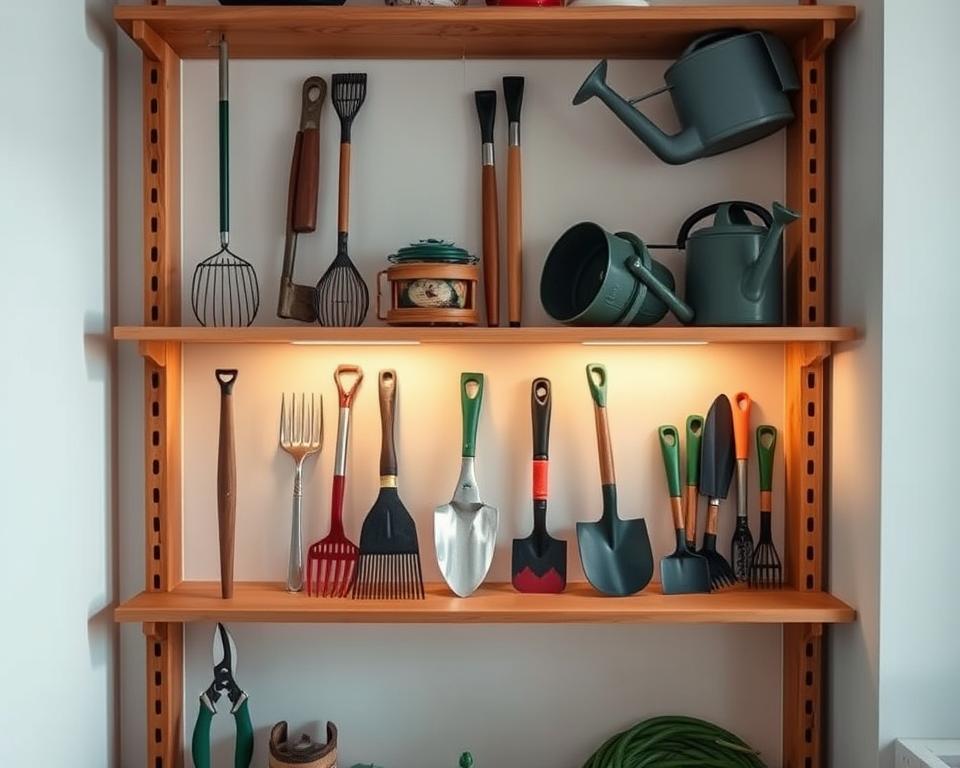
Magnetic strips work brilliantly for smaller metal tools like secateurs and trowels. Install these strips at comfortable heights to prevent strain when retrieving tools. Tool racks designed for specific items, such as rake and spade holders, keep long-handled tools secure and prevent them from falling.
Cabinet and Drawer Organisation
Dedicated cabinets with drawers provide excellent protection for smaller hand tools and delicate equipment. This storage method keeps tools dust-free whilst allowing for detailed organisation by type or frequency of use.
Use drawer dividers to create compartments for different tool categories. Label each section clearly to maintain your organisational system. Soft-close drawers prevent damage from slamming and reduce noise in your storage area.
Climate Control Considerations
Proper climate control significantly extends tool life in indoor storage environments. Installing a dehumidifier reduces moisture levels that cause rust and corrosion. Aim to maintain humidity levels below 50% for optimal tool preservation.
Ensure adequate ventilation to prevent stagnant air buildup. Small fans or vents help circulate air and prevent condensation. These simple climate control measures protect your investment and maintain peak tool performance year-round.
Outdoor Storage Options and Weatherproofing
Many gardeners face the challenge of storing tools outdoors whilst maintaining their condition and security. Outdoor storage solutions offer practical alternatives when indoor space is limited, but success depends entirely on choosing the right equipment and implementing proper weather protection measures.
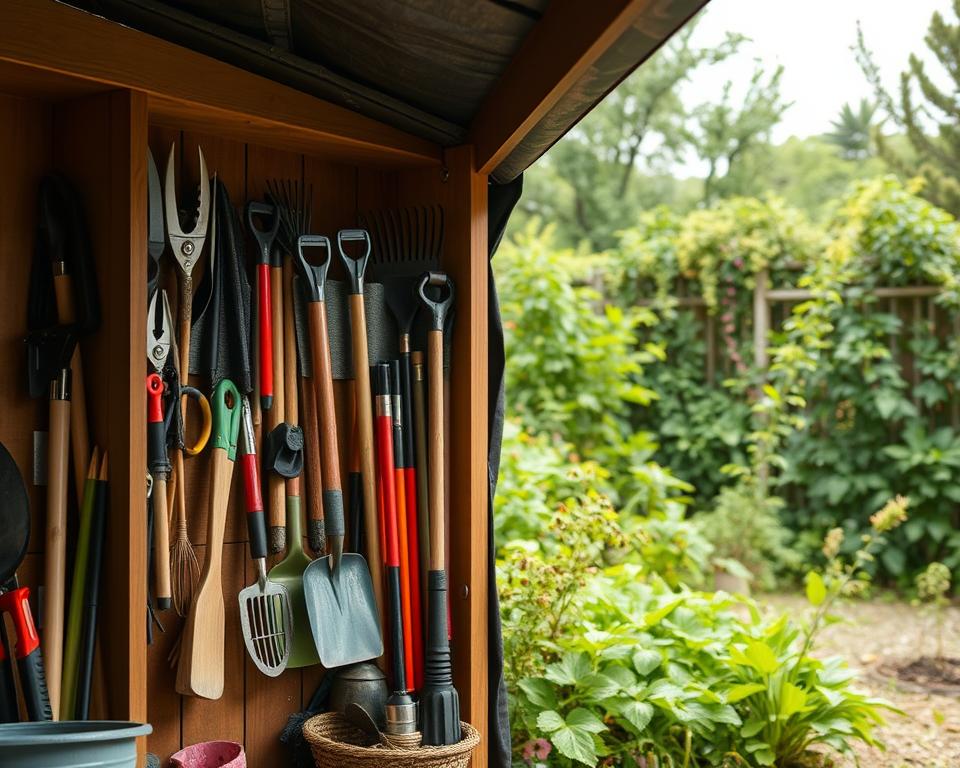
Choosing Weather-Resistant Storage Units
The foundation of successful outdoor storage lies in selecting units built from durable, weather-resistant materials. Galvanised steel storage units provide excellent protection against rust and corrosion, making them ideal for Britain’s damp climate.
Treated timber options offer natural insulation properties whilst blending seamlessly into garden environments. High-quality plastic resin units resist cracking in freezing temperatures and won’t warp during hot summer months.
Consider units with sloped roofs to encourage water runoff and prevent pooling. Proper drainage around your storage area prevents water accumulation that could seep into the unit and damage your tools.
Tool Sheds and Lockable Storage Boxes
Purpose-built tool sheds represent the premium solution for outdoor storage, offering ample space for tools of all sizes. These structures can accommodate custom shelving systems, wall-mounted hooks, and dedicated spaces for power tools.
Lockable storage boxes provide security and portability for smaller tool collections. They’re particularly valuable for allotment holders who need weatherproof protection without permanent installation.
Metal storage boxes with reinforced hinges and weatherproof seals offer superior protection against both theft and weather damage. Look for units with internal mounting points for organising smaller tools efficiently.
Protecting Against Moisture and Pests
Weather protection extends beyond choosing the right storage unit—moisture management requires ongoing attention. Install adequate ventilation to prevent condensation buildup, which can cause rust even in sealed environments.
Place moisture-absorbing products like silica gel packets or dehumidifying crystals inside your storage unit. These products actively remove excess humidity and create a drier environment for your tools.
Pest control measures protect both your tools and storage space integrity. Seal any gaps where rodents might enter, as they can damage wooden handles and create nesting areas. Regular inspection helps identify pest activity before it becomes problematic.
Raise storage units slightly off the ground using concrete blocks or treated timber bases. This simple step prevents moisture wicking from the ground and reduces pest access points significantly.
Seasonal Storage Strategies
Different seasons demand unique storage approaches to keep your gardening equipment in peak condition. Seasonal storage planning ensures your tools remain functional and accessible when you need them most. The changing British weather patterns require gardeners to adapt their storage methods throughout the year.
A well-organised seasonal approach prevents damage from temperature fluctuations and moisture changes. It also helps you manage the varying demands of different gardening seasons effectively.
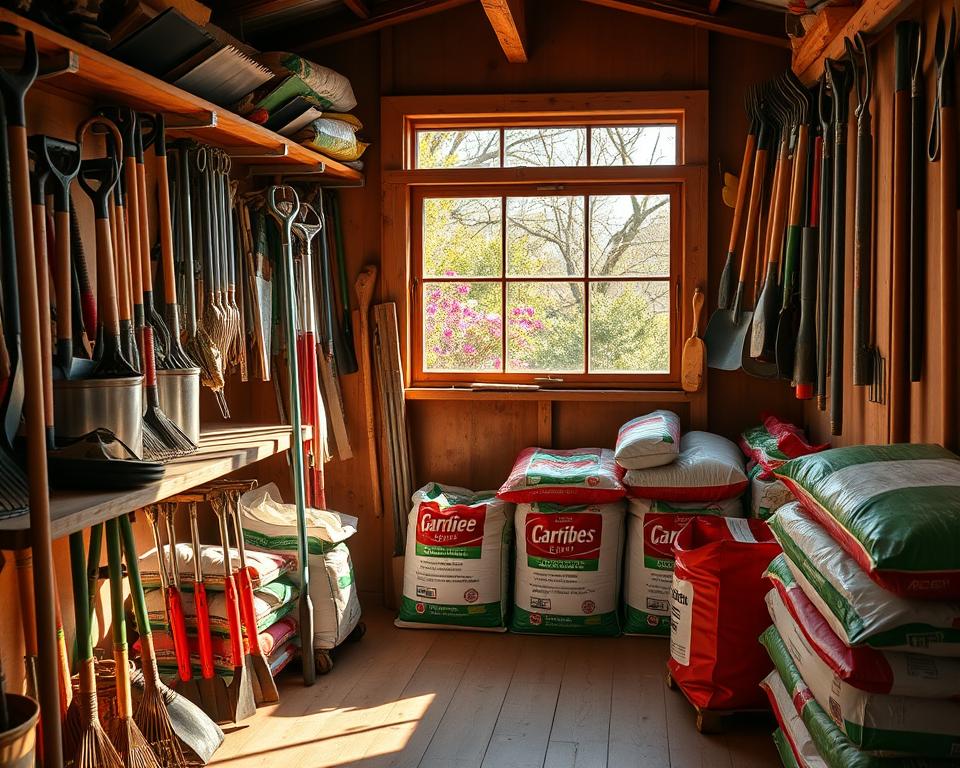
Winter Storage Preparation
Winter preparation becomes crucial as temperatures drop and gardening activity decreases significantly. Clean all tools thoroughly before storing them for the colder months. Remove any soil, sap, or plant debris that could harbour moisture and cause rust.
Apply a thin layer of oil to metal surfaces to prevent corrosion during storage. Wooden handles benefit from treatment with linseed oil to prevent cracking in cold conditions. Store tools in a dry, frost-free location where temperature remains relatively stable.
Power tools require special attention during winter months. Remove batteries and store them separately in a warm, dry place. Clean air filters and check fuel systems before putting petrol-powered equipment away.
Summer Tool Rotation Systems
Summer brings increased gardening activity and the need for efficient tool rotation. Keep frequently used items like secateurs, trowels, and watering equipment easily accessible near your main gardening areas. Less commonly used tools can be stored in secondary locations to avoid clutter.
Create designated zones for different types of gardening work. Position weeding tools near vegetable patches and pruning equipment close to shrub borders. This system saves time and reduces wear on tools from unnecessary handling.
Consider weather protection for tools left outdoors temporarily. A simple tool caddy with weather-resistant materials keeps essentials dry during sudden summer showers.
Creating a Seasonal Maintenance Schedule
A structured maintenance schedule keeps your seasonal storage system running smoothly throughout the year. Plan major cleaning sessions for spring and autumn when gardening demands change significantly.
“A stitch in time saves nine – and that’s especially true for garden tool maintenance.”
Schedule blade sharpening for early spring before the busy growing season begins. Plan handle treatments for late spring when tools see increased use. Reserve comprehensive cleaning and oiling tasks for late autumn preparation.
Keep a simple calendar noting when each maintenance task should occur. This prevents forgotten maintenance and ensures your tools remain in excellent condition year-round.
Long-Term Tool Maintenance During Storage
Proper long-term tool maintenance transforms storage from a passive process into an active preservation system that safeguards your equipment. This comprehensive approach ensures your garden tools emerge from storage in excellent working condition, ready for immediate use. Strategic maintenance during extended storage periods protects your investment and prevents costly replacements.
Successful long-term storage requires regular attention to three critical areas: metal protection through proper lubrication, wooden handle preservation, and cutting edge maintenance. Each component demands specific care techniques that work together to maintain tool integrity throughout storage periods.
Oil and Lubrication Techniques
Tool lubrication forms the cornerstone of effective long-term storage maintenance. Light machine oil or specialised tool oils create a protective barrier that prevents moisture penetration and corrosion formation. Apply oil sparingly to all metal surfaces, ensuring complete coverage without creating thick residues that attract dirt and debris.
Focus particularly on moving parts, joints, and pivot points during the lubrication process. These areas are most susceptible to seizing during extended storage periods. Wipe excess oil away after application to prevent accumulation of garden debris when tools return to active use.
For tools with complex mechanisms like secateurs or hedge trimmers, operate them periodically during storage to distribute lubricants evenly. This practice prevents internal components from sticking and maintains smooth operation throughout the storage period.
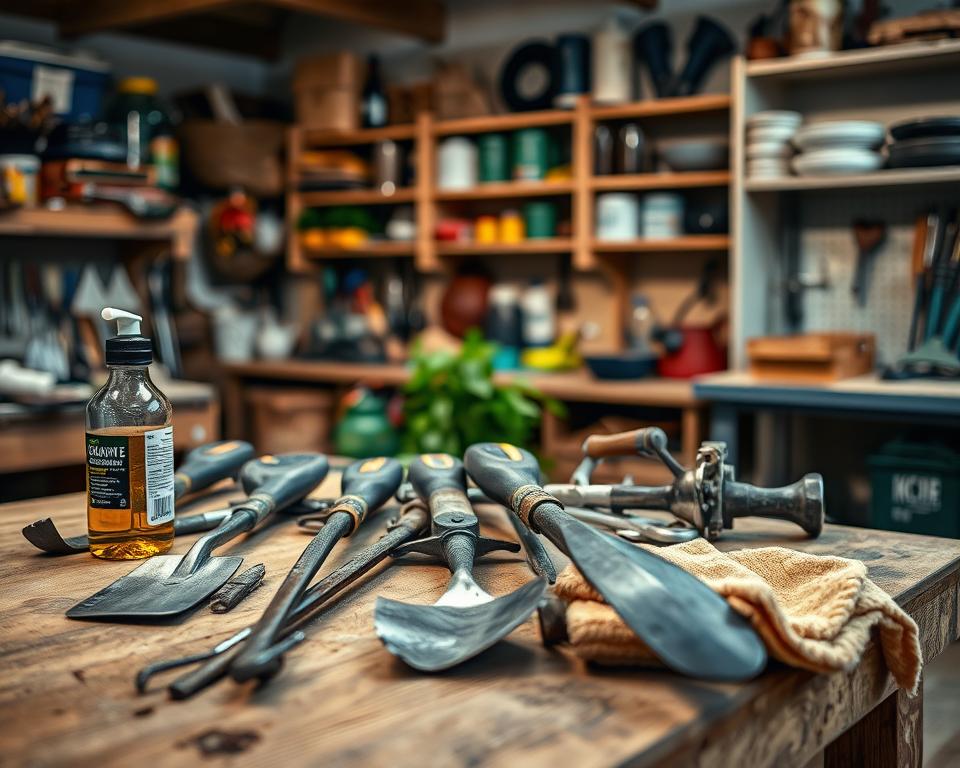
Handle Care and Wood Treatment
Wooden handles require specific preservation techniques to prevent cracking, splitting, and moisture absorption that compromises tool integrity. Regular treatment with boiled linseed oil maintains the wood’s natural flexibility and moisture resistance. Apply the oil using a clean cloth, working it into the grain thoroughly.
Specialised wood preservatives offer additional protection against fungi and bacteria growth during humid storage conditions. Check wooden handles monthly during long-term storage for signs of loosening or damage. Tighten loose heads immediately to prevent further deterioration.
Store tools with wooden handles in areas with stable humidity levels when possible. Extreme temperature fluctuations cause wood expansion and contraction that leads to splitting and loose connections.
Blade Sharpening and Protection Methods
Blade maintenance during storage involves ensuring cutting edges are properly sharpened before storage begins. Sharp blades resist corrosion better than dull ones and perform optimally when returned to service. Use appropriate sharpening tools for each blade type, maintaining the correct angle throughout the process.
Protect sharpened edges with blade guards or light oil coatings during storage. This prevents accidental damage and maintains the cutting edge’s sharpness. Never store blades in direct contact with other metal surfaces, as this causes dulling through friction.
For pruning tools and cutting implements, apply a thin layer of protective oil to prevent rust formation on the blade surface. Check blade condition monthly and reapply protection as needed throughout the storage period.
| Tool Type | Lubrication Method | Handle Treatment | Blade Protection |
|---|---|---|---|
| Spades & Forks | Light machine oil on metal surfaces | Linseed oil every 3 months | Oil coating on cutting edges |
| Pruning Shears | Pivot point lubrication monthly | Wood preservative treatment | Blade guards plus oil protection |
| Hand Tools | Thin oil layer on all metal | Regular moisture checks | Edge protection with guards |
| Hedge Trimmers | Moving parts operation monthly | Grip area conditioning | Comprehensive blade maintenance |
Regular maintenance schedules ensure consistent tool protection throughout storage periods. Document maintenance activities to track when each tool received attention and identify tools requiring additional care. This systematic approach maximises tool longevity and performance reliability.
Organising Tools by Type and Frequency of Use
A well-organised tool storage system becomes the foundation of efficient gardening, making every task smoother and more enjoyable. Effective tool organisation requires thoughtful planning that considers both the physical characteristics of your equipment and your personal gardening habits. The key lies in creating logical groupings that make sense for your specific needs whilst ensuring quick access to frequently used items.
Your organisation strategy should prioritise accessibility above all else. Daily-use tools deserve prime real estate in your storage area, whilst seasonal equipment can occupy less convenient spaces. This approach saves time and reduces frustration during busy gardening periods.
Categorising Hand Tools vs Power Tools
Hand tools and power tools require distinctly different approaches to storage systems due to their varying sizes, weights, and maintenance needs. Hand tools like trowels, secateurs, and hand forks work best when grouped together in easily accessible locations. These lightweight implements can be stored on wall-mounted racks, in drawer organisers, or hanging systems that keep them visible and within reach.
Power tools demand more substantial storage solutions. Their weight requires sturdy shelving or floor-based storage units that can support the load safely. Battery-powered tools need special consideration for charging stations and battery storage, whilst corded tools require organised cable management to prevent tangling and damage.
Consider creating separate zones for each category:
- Hand tool zone: Wall-mounted pegboards, magnetic strips, or shallow drawers
- Power tool zone: Heavy-duty shelving with dedicated charging areas
- Long-handled tool zone: Vertical racks or hooks for spades, rakes, and hoes
- Seasonal tool zone: Higher shelves or back areas for infrequently used items
Creating an Accessible Storage System
Accessibility forms the cornerstone of practical tool organisation. The most frequently used tools should occupy the most convenient locations—typically at eye level and within easy arm’s reach. Heavy items like lawnmowers or large power tools belong at ground level to avoid dangerous lifting, whilst sharp tools need secure mounting with protective covers.
Your storage layout should follow the “golden triangle” principle used in kitchen design. Position your most-used tools within a comfortable working triangle that minimises movement and maximises efficiency. This might mean placing hand tools near your potting bench, with watering equipment close to the water source.
Consider these accessibility factors when designing your storage systems:
- Height placement based on frequency of use and weight
- Clear sight lines to identify tools quickly
- Adequate spacing to remove tools without disturbing others
- Non-slip surfaces and secure mounting for safety
Remember that accessibility needs may change with seasons. Your summer layout might prioritise lawn care equipment, whilst winter organisation should emphasise pruning tools and maintenance supplies.
Labelling and Inventory Management
A comprehensive labelling system transforms even the most organised storage into a professional-grade setup. Labels serve multiple purposes: they help family members return tools to correct locations, assist with quick identification, and support inventory management for insurance or replacement purposes.
Digital inventory management has become increasingly valuable for serious gardeners. Simple smartphone apps or spreadsheets can track purchase dates, warranty information, maintenance schedules, and current condition. This information proves invaluable when planning replacements or filing insurance claims.
“The bitterness of poor quality remains long after the sweetness of low price is forgotten.”
Your labelling strategy should include:
- Clear identification: Tool names and designated storage locations
- Maintenance reminders: Service dates and upcoming maintenance needs
- Safety information: Handling instructions for power tools
- Inventory codes: Simple numbering systems for tracking purposes
Consider using colour-coded labels to distinguish between tool categories or seasonal items. Weather-resistant labels ensure longevity in garage or shed environments where temperature and humidity fluctuate.
Regular inventory reviews help maintain system effectiveness. Monthly checks during active gardening seasons and quarterly reviews during dormant periods keep your tool organisation current and functional. This practice also highlights tools that may need replacement or repair before the next heavy-use period begins.
Common Storage Mistakes to Avoid
Most tool damage happens during storage rather than active use, highlighting the importance of proper practices. Understanding these storage mistakes can save you considerable money whilst protecting your gardening investment. Even experienced gardeners sometimes fall into these traps without realising the long-term consequences.
Recognising and avoiding these common errors will dramatically extend your tools’ lifespan. Let’s explore the most damaging habits that could be costing you money.
Storing Dirty or Wet Tools
Putting away dirty or damp tools is the worst mistake you can make. Soil particles trap moisture against metal surfaces, creating perfect conditions for rust formation. Even tiny amounts of garden debris can cause serious damage over time.
Wet tools are equally destructive. Water accelerates corrosion and encourages bacterial growth on wooden handles. This combination leads to:
- Rapid rust development on metal components
- Wood rot and handle deterioration
- Blade dulling from mineral deposits
- Joint loosening and structural weakness
Always clean and thoroughly dry your tools before storage. This simple habit prevents most tool damage prevention issues.
Overcrowding Storage Spaces
Cramming too many tools into limited space creates numerous problems. Tools knock against each other, causing chips and scratches. Sharp edges can damage handles and cutting surfaces of neighbouring tools.
Overcrowded storage also restricts air circulation. Poor airflow traps moisture, leading to rust and mould growth. Additionally, retrieving tools becomes dangerous when they’re tightly packed together.
Proper spacing offers several benefits:
- Improved air circulation around each tool
- Easier identification and access
- Reduced risk of accidental damage
- Better moisture control
Plan your storage layout thoughtfully. Each tool should have adequate space without touching others.
Neglecting Regular Maintenance Checks
Skipping routine inspections is a costly oversight. Small problems quickly escalate into expensive repairs or replacements. A loose handle or tiny rust spot can become a major issue within months.
Regular maintenance checks should include:
- Handle tightness and condition assessment
- Rust spot identification and treatment
- Blade sharpness evaluation
- Moving parts lubrication needs
Schedule monthly inspections during active gardening seasons. Reduce frequency to quarterly checks during winter storage periods. This proactive approach catches issues early when they’re still manageable.
Remember, prevention costs far less than replacement. Avoiding these common storage mistakes will keep your tools in excellent condition for years to come.
Conclusion
Implementing this comprehensive garden tool storage guide will transform how you maintain your gardening equipment. Your tools will last longer, perform better, and remain ready for any gardening task that comes your way.
Start with small steps. Choose one storage method from this guide and apply it to your most frequently used tools. Clean them properly, select an appropriate storage location, and establish a simple maintenance routine. Once you see the positive results, expand these practices to your entire tool collection.
The investment in proper storage systems pays dividends through reduced replacement costs and improved gardening efficiency. Your spades will cut through soil more easily, your pruning shears will make cleaner cuts, and your power tools will start reliably when needed.
Remember that consistency matters more than perfection. Regular cleaning after use, proper drying, and organised storage will keep your tools in excellent condition. These tool care tips become second nature with practice, making them part of your natural gardening routine.
Your garden deserves quality tools, and quality tools deserve proper care. Begin implementing these storage strategies today, and you’ll enjoy years of reliable service from your gardening equipment whilst maintaining the beautiful outdoor spaces you’ve worked hard to create.
FAQ
How often should I clean my garden tools before storing them?
You should clean your garden tools immediately after each use to prevent soil, sap, and organic matter from hardening on the surfaces. This routine cleaning prevents permanent damage and makes the storage process much more effective. For tools used daily during growing season, a quick brush-off and wipe-down is sufficient, whilst tools used less frequently should receive a thorough cleaning with proper drying before storage.
What’s the best way to prevent rust on metal garden tools during storage?
The most effective rust prevention involves thorough drying after cleaning, followed by a light application of machine oil or specialised tool oil to all metal surfaces. Store tools in a dry environment with good ventilation, and consider using a dehumidifier in storage areas prone to high humidity. Ensure tools are completely dry before applying oil, as trapped moisture can actually accelerate rust formation.
Should I store my garden tools indoors or outdoors?
Indoor storage is always preferable as it provides better protection from moisture, temperature fluctuations, and weather damage. Garages and sheds offer ideal conditions with controlled environments. However, if outdoor storage is necessary, invest in high-quality weatherproof storage units made from galvanised steel or treated timber, and ensure proper drainage and ventilation around the storage area.
How do I properly maintain wooden handles during long-term storage?
Wooden handles require regular treatment with boiled linseed oil or specialised wood preservatives to prevent cracking and moisture absorption. Clean handles thoroughly, allow them to dry completely, then apply a thin coat of oil, working it into the grain. This treatment should be done before winter storage and periodically throughout the year to maintain the wood’s flexibility and natural resistance to moisture.
What’s the most efficient way to organise my garden tool storage?
Organise tools by frequency of use and type. Store daily-use items like hand forks and secateurs in the most accessible locations, whilst seasonal tools can occupy less convenient spaces. Use wall-mounted systems like pegboards for hand tools, and group similar items together. Label storage areas and maintain an inventory to track maintenance schedules and tool locations.
Can I store power tools with my hand tools?
Whilst you can store them in the same area, power tools require separate consideration due to their specific needs. They need protection from moisture, proper battery management, and cord organisation. Store batteries separately in temperature-controlled environments, and ensure power tools are completely clean and dry. Consider dedicated shelving or cabinets for power tools to protect their more complex mechanisms.
How do I protect my tools from pests in outdoor storage?
Ensure your storage unit has proper sealing around doors and windows to prevent rodent entry. Use steel wool to fill small gaps, as rodents cannot chew through it. Keep the storage area clean and free of food sources, and consider using natural deterrents like peppermint oil. Regularly inspect wooden handles for signs of pest damage, and maintain good drainage around the storage unit to reduce insect attraction.
What should I do if I find rust on my stored tools?
Address rust immediately to prevent further spread. For light surface rust, use fine steel wool or sandpaper to remove it, then clean the area thoroughly and apply protective oil. For more severe rust, you may need naval jelly or rust removal products. After treatment, ensure the tool is completely dry and apply a protective coating. Consider whether the storage environment needs improvement to prevent future rust formation.
How often should I inspect my stored garden tools?
Conduct monthly inspections during active gardening seasons and quarterly checks during winter storage. Look for signs of rust, loose handles, pest damage, or moisture buildup in the storage area. This regular monitoring helps identify problems early when they’re easier and less expensive to address. Keep a simple log of inspection dates and any issues found.
Is it worth investing in expensive storage systems for garden tools?
Quality storage systems are definitely worthwhile when you consider the cost of replacing damaged tools. Premium brands like Spear & Jackson and Wilkinson Sword tools can cost hundreds of pounds for a complete set. A well-designed storage system protects this investment, improves organisation, and saves time when gardening. Choose storage solutions that match your tool collection size and available space, focusing on durability and weather protection.

